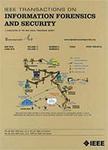版权所有:内蒙古大学图书馆 技术提供:维普资讯• 智图
内蒙古自治区呼和浩特市赛罕区大学西街235号 邮编: 010021

作者机构:Shanghai Jiao Tong Univ SJTU Dept Elect Engn Shanghai 200240 Peoples R China Natl Univ Def Technol Sch Informat & Commun Wuhan 430010 Peoples R China Univ Elect Sci & Technol China Natl Key Lab Sci & Technol Commun Chengdu 611731 Peoples R China Univ Kent Sch Engn Canterbury CT2 7NT England
出 版 物:《IEEE TRANSACTIONS ON INFORMATION FORENSICS AND SECURITY》 (IEEE Trans. Inf. Forensics Secur.)
年 卷 期:2025年第20卷
页 面:1503-1518页
核心收录:
学科分类:0808[工学-电气工程] 08[工学] 0812[工学-计算机科学与技术(可授工学、理学学位)]
基 金:National Natural Science Foundation of China Shanghai Municipal Science and Technology Major Project [2021SHZDZX0102]
主 题:Receivers Array signal processing Encoding System performance Rician channels Optimization Performance gain Band-pass filters Graphical models Distribution functions Covert communication space-time coding intelligent reflecting surface phase and frequency optimization
摘 要:Covert communication is an important approach to ensure information security by hiding the transmission behavior. Space-domain-coding intelligent reflecting surface (SDC-IRS) can adjust the phase of the reflection signal for passive beamforming in angle domains, which is widely employed in covert communications. However, the gains by SDC-IRS vanish when the warder is proximal to the receiver in angle domains. To overcome this limitation, in this paper, the space-time-coding IRS (STC-IRS) is considered, which can adjust both the phase and the frequency of the reflection signal for passive beamforming in angle-distance domains. Specifically, system performance under STC-IRS and SDC-IRS is compared, revealing the essence that angle and distance discrimination for the receiver is achieved with STC-IRS. Further, to fully exploit STC-IRS, optimization problems are formulated to maximize the covert rate in both line-of-sight scenarios and Rician fading scenarios. To solve the above problems, penalty-based algorithms are proposed where the transmit power, the phase shift and the frequency shift at STC-IRS are optimized jointly with majorization-minimization and block successive upper bound minimization techniques. Considering more general and adverse cases, the proposed algorithms are also extended to the scenario with multiple warders. Simulation results demonstrate the superiority of the proposed scheme compared with other benchmarks. Especially, when the warder and the receiver overlap in angle domains, covert rates with STC-IRS exceed 3 bps by distance domain discrimination, whereas covert rates with SDC-IRS are less than 0.01 bps.